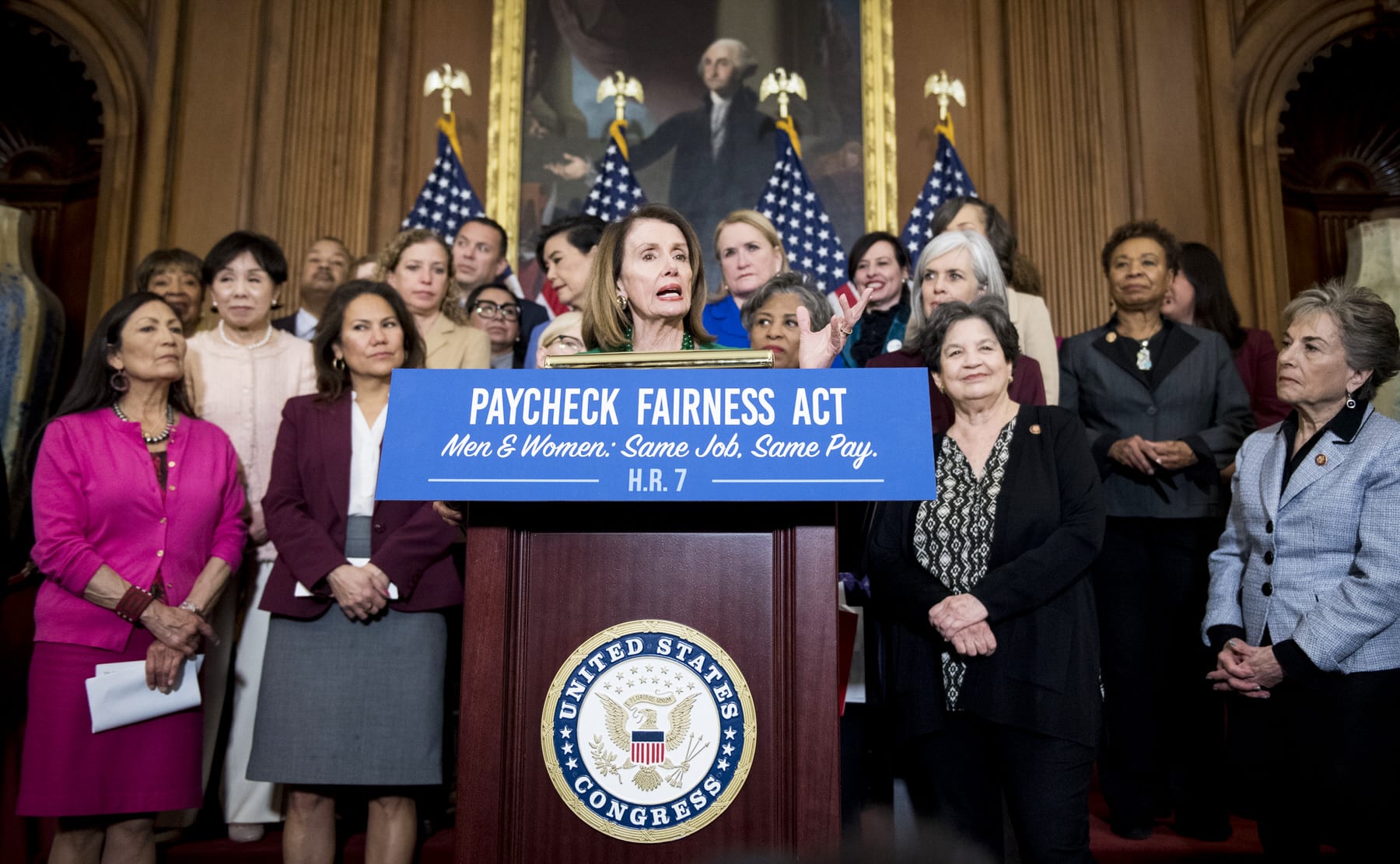On April 11, 1996, the country marked the first Equal Pay Day — the symbolic day on which women would catch up to the pay White men earned the year before. In marking it, activists hoped to eradicate it. At the time, the women were earning 75 cents for every $1 earned by White men.
Now, 25 years later, the United States has improved on that measure by only about two and a half weeks. This year, Equal Pay Day is held March 24. Women still make about 82 cents on $1 for White men, and women of color won’t start marking their Equal Pay Day until well into summer: Black women earn 63 cents, American Indian and Alaska Native women earn 60 cents, and Latinas earn 55 cents compared with their White man counterparts. Asian American or Pacific Islander women earn 85 cents, though they face much starker wage gaps across ethnic groups.
At the current rate, it will take until about 2059 before women reach parity with men.
For much of modern American history, the glacial pace of growth on wages has been the central story of women in the workplace. Even with the passage of the 1963 Equal Pay Act outlawing pay discrimination on the basis of sex, the pay gap barely budged for decades: It was 58 cents in 1939, 59 cents in 1959, and 59 cents still in 1977, according to a 1979 article in the New York Times.
“Women’s educational levels are on average as high as men’s, but women who have completed four years of college earn less than men who have completed the eighth grade,” Frances Hutner, an economist specializing in women’s role in the U.S. economy, said at the time.
The causes then and now are numerous. Women continue to shoulder the majority of at-home responsibilities and have fewer workforce protections if they have children or need to care for a sick family member. They are more likely to face work disruptions that make it harder to achieve higher pay and are handling multiple other layers of pay discrimination, said Jocelyn Frye, a senior fellow at the Center for American Progress’ Women’s Initiative.
“You pay women workers less — you think that they’re less valuable — and you promote men more frequently or you have them in higher-level jobs,” Frye said. “That is a phenomenon that has happened for years, and that also is part of the reason that the pay gap persists.”
According to a report by the Institute for Women’s Policy Research, the pay gap exists in nearly every occupation. Even in occupations that are dominated by women, such as education, men were paid higher weekly wages, the report found.
And oftentimes, the top jobs for women in terms of representation are among the lowest paid — women currently make up two-thirds of the lowest-paid jobs in the country.
Perhaps no year has put that into stark relief like 2020, when America recorded its first women’s recession. Years of pay inequity, occupational segregation that forced women into lower-paid jobs and lack of policies to help working women led to the loss of nearly 11 million jobs held by women from February to May of 2020. From February 2020 to February 2021, 2.3 million women have completely left the labor force, compared with 1.8 million men. And women’s labor force participation rate has not been this low since 1988.
What happened unfolded in three parts. Women were over-concentrated in the jobs that were most vulnerable to closures. If they had children, they were more likely than their partners in heterosexual relationships to take on the bulk of the child care. And if it became impossible to juggle work and child care, women were the most likely to leave their jobs in part because they often earned less than their partners in opposite-sex couples.
Vice President Kamala Harris has called it a “national emergency” that “demands a national solution.” But the problem is vast and systemic. Here are three of the main roadblocks that still stand in the way.
Occupational segregation
So much of the reason why women are in the most vulnerable, lowest-paid jobs dates back to the history of that work. During the New Deal, Southern Democrats in Congress worked to exclude farm workers and domestic service from labor protections including minimum wage, overtime pay and collective bargaining rights.
Tipped workers, too, have a history that dates back to slavery. Prior to 1850, waiters were largely men and earned a full wage, but influence from Europe on tipping coincided with emancipation, and the restaurant industry saw an opportunity to hire newly freed slaves, many of them women of color, and pay them nothing by implementing a $0 tipped wage, said Saru Jayaraman, the president of One Fair Wage, an organization advocating for the elimination of the two-tier wage system.
Today, while the federal minimum wage is $7.25, the minimum for tipped workers is $2.13, with the expectation that tips will make up the difference. But women are the vast majority of tipped workers, and that system has been well-documented to invite pervasive sexual harassment.
Nearly 40 percent of all the net job losses for women in the past year have been in the hospitality industry, according to a report by the National Women’s Law Center.
Other sectors hit particularly hard in the pandemic are dominated by women: 95 percent of child care workers, 70 percent of servers, 90 percent of home health aides and 88 percent of housekeepers are women. In retail, 98 percent of the net job losses in that field from February 2020 to February 2021 were sustained by women.
There have been attempts to close the pay gap by raising the minimum wage to $15 an hour and eliminating the tipped wage, a policy that is considered one of the most effective to close the gender pay gap. Studies by the nonpartisan Congressional Budget Office have found that raising the minimum wage could raise incomes for 17 million people, many of them women.
But in the most recent round of relief, the minimum wage hike was left out of President Joe Biden’s $1.9 trillion economic plan due to Senate rules, and an increase to $15 an hour has faced opposition in both parties.
Still, pay is half of the equation on occupational segregation and pay parity. The other half is workplace protections like sick leave and parental leave. Low-wage workers are the least likely to have those protections in place, and so their relationship with the labor force is more tenuous, able to more easily splinter if care is disrupted or a worker becomes sick.
In the last year, the country saw “devastation for women’s employment” almost exclusively because “we have fundamentally failed to adopt the policies necessary to maximize the ability of women to participate in the workforce,” Frye said.
A push, supported by Harris and numerous women’s leaders, is underway to expand paid leave provisions in the next economic package, as well as readdress the increase of the minimum wage.
“What we’re trying to say President Biden and Majority Leader [Chuck] Schumer is … we cannot negotiate away a lesser wage for any of these workers, because that would be tantamount to legalizing gender pay inequity,” Jayaraman said.
The caregiving crisis
Before the pandemic, women’s ability to work was already impacted by child care, both the expense and the availability. But when the pandemic shuttered day cares and schools and parents were forced to stay at home with their kids, the crisis intensified.
In September alone, when many classes restarted virtually, an estimated 1.6 million mothers left the workforce specifically because of the loss of child care options.
Historically, the U.S. has acknowledged that child care is a critical part of ensuring women remain in the workforce. During World War II, the country enacted its only national child care program to provide care for the children of women who were joining the labor force in factories or government offices to aid the war effort. But when the war ended, so did the program.
When women leave the labor force for some time, it often leads to them returning to the workforce in positions that pay less.
In past recessions, that trend has actually narrowed the gender pay gap because men were more likely to lose their jobs. But the pandemic recession is the opposite and could set women back on pay parity as much as 20 years, to 76 cents on the White man’s $1, according to a study by economists at Northwestern University.
Building up the social safety net around child care, then, is a key focus for women’s advocates. In his upcoming infrastructure plan, Biden has committed to treating child care as infrastructure.
Early discussions of the administration’s plan, which has not yet been finalized, indicate it will include a proposal for universal prekindergarten, a national paid leave program and a further extension of the child tax credit, which was recently expanded for one year to be available for the neediest families.
Pay secrecy
The secrecy around salaries — and, importantly, who has access to salary data — is another persisting contributor to pay inequity, and one that officials at the state and federal level have at times attempted to address.
Former President Barack Obama issued a Fair Pay and Safe Workplaces executive order, which required companies with federal contracts to comply with 14 labor and civil rights laws, including a paycheck transparency rule. But former President Donald Trump’s administration eliminated the order over concerns regarding a provision requiring federal contractors to report labor violations.
Since taking office, Biden has formed a Gender Policy Council, which, among other priorities, will set out to decrease the persisting wage gap. But he has not yet issued an executive order on pay equity.
Congress this year reintroduced the Paycheck Fairness Act, which would ban employers from asking prospective employees about their salary history, strengthen protections, build in more pay transparency and protect workers from retaliation. The bill would build on the foundation of the Equal Pay Act, passed in 1963, and the Lilly Ledbetter Fair Pay Act, passed in 2009, by closing loopholes, including specifically requiring employers to prove a pay disparity exists for a legitimate reason.
In 2020, the House passed the bill with the support of seven Republicans, and it’s again up for consideration but faces significant hurdles from Republicans who believe it will encourage lawsuits.
At the state and local level, efforts are already underway to address persistent gaps.
Since 2017, there’s been increased momentum to ban prospective employers from asking about salary history, considered a “textbook example of structural bias,” according to a report by the Center for American Progress, a liberal think tank. Salary history is often used to compare applicants and inform salary negotiations — something that builds on existing inequalities and carries them from one workplace to another.
So far, 19 states, Washington, D.C., Puerto Rico and 20 localities have passed salary history bans. And there’s some research that indicates the laws have helped narrow gender pay gaps. A California study last year found that salary history bans led to more pay equity and higher pay for women, particularly those over the age of 35 with young children.
“If you look over 10, 20 years, states have moved forward. Some of these issues may be controversial in the Congress, but the states have nonetheless moved forward on them,” Frye said.
In 2018, for example, New Jersey passed an equal pay law prohibiting employers from paying members of a certain class less — expanding the federal definition from just gender to also include race, religion, sexual orientation, gender identity, disability or another characteristic.
The law also expands protections for employees, granting them up six years of back pay — up from two years — in the case of a successful claim, widens the definition of equal pay for equal work to “substantially similar work,” and builds on the anti-retaliation provision to protect workers who seek legal counsel.
New Jersey is also one of the states that passed a salary history ban, something Gov. Phil Murphy championed because it led to a cycle of pay disparity.
“Part of the reason why women were consistently digging out of a hole was because they came to a particular phase of the career already in a hole,” Murphy said.
He said he disagrees with assessments from some Republican members of Congress that further equal pay laws are unnecessary because there are already laws in place that should protect against that type of discrimination.
“I don’t think there’s any amount that’s too much to throw at this to get it right,” he said. “I do think we are in the midst of a sea change. It will only be a matter of time until states will look to their left and to their right and they’ll say, ‘Well this is just part of who we are, part of how we do business.’”






